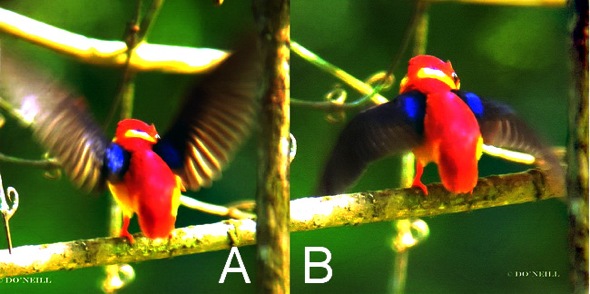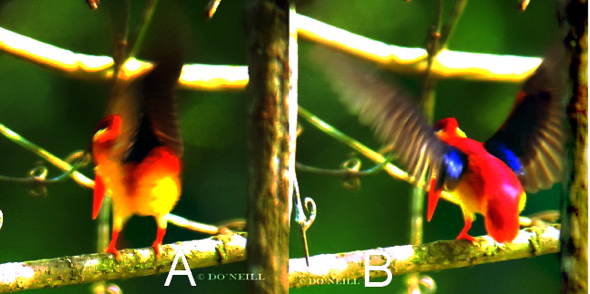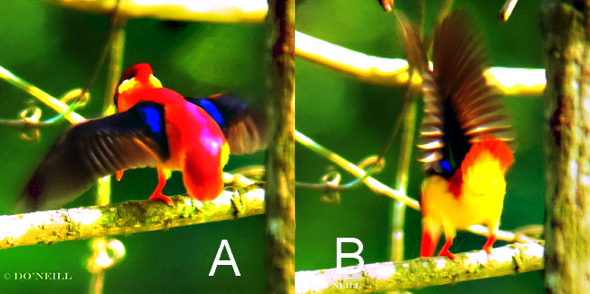“A rare and observation opportunity came in a form of a 14cm dwarf sized kingfisher – caught in action, preparing for a breakfast dive, into a sluggish stream tributary off a Tawau River in N. Borneo (Sabah).
“Here is a supposing male photographed in full concentration of its moving, breakfast target… a probable fish (above).
“Subsequent photographs provide the opportunity to study rear plumages of this species that differentiate Oriental Dwarf Kingfishers into two forms: Black-backed (Ceyx erithaca) and Rufous-backed (Ceyx rufidorsa) Kingfisher.
“Two Field Bird Guide Books have different versions. There appear to be hybrids as well with variable degree of black on its feathering – a motleyi?
“Thus readers can decide what or which name one chooses most comfortable to use bearing in mind, in one field guide, recent molecular studies suggest Ceyx erithaca probably is not found in Borneo – (Ref: A Field Guide to the Birds of Borneo by Susan Myers and Phillipp’s Field Guide to the Birds of Borneo- Quentin and Karen Phillipps).
“For now, let’s take this opportunity to appreciate rear plumages of this ‘hybrid’ species that best live up to its name- ‘Rufous backed’ as this colourful October bird took to its Olympian dive.
“Rufidorsa raised both its butterfly looking wings upwards when target was spotted. They revealed black to grey-brown upper winged feathers with two prominent bright, blue spots on its scapulars to contrast a rufous- red crown to upper tail. An interesting central splash of lilac flashed from mantle to rump (below-left).
“In full concentration, the dwarf size fisherman allowed both its wings to shoulder hang as he followed the swimming target (above-right).
“The next plate showed Rufidorsa was about to take his dive. He cocked its tail and clasped his wings like divers did with their hands (below-left).
“Somehow, the aim was not quite at hand to dive for its moving target- supposedly… swimming fish. Rufidorsa was observed to momentarily retract, parted his wings above and uncorked its tail (above-right).
“Waiting with wings hanging off shoulder level, the perfect moment of opportunity came. Quick to the sprint, Olympian diver reclasped its wings, recocked its tail of orangey under tail coverts, Rufidorsa took off like a fiery rocket and disappeared at the blink of my eye downwards to a watery edge (below).
Avian Writer Daisy O’Neill
Penang, Malaysia
Copyright article and all copy images – Courtesy of Daisy O’Neill Bird Conservation Fund













2 Responses
The classification of this kingfisher again raises the controversy between the “Splitters” and the “Lumpers” in scientific taxonomy. Daisy, you say that there are two colour forms, with a variety of intermediate forms. And on this basis, some taxonomists think that there are two species.
Well, in the case of the Rainbow Lorikeet (Trichoglossus haemotodus) there are at least 20 colour forms. Some of them look so different that any layman would consider them different species. And in the case of Shamas (Copsychus malabarius) at least a dozen different varieties have been recoded. The same is true of the common Magpie Robin (Copsychus saularis). As the three examples I have just mentioned are popular in aviculture, it was possible, in the days before import restrictions, to see the entire gamut of variants in the local bird shops.
The common test for elevating any animal to full species status is, if it should breed with another variety, would fertile offspring result.
In the case of the three examples mentioned, as they are often raised in aviaries, we know that they will interbreed freely, and that the offspring are fertile.
Anyone care to settle the question of whether there is one or are there two species by studying the genealogy of dwarf kingfishers?
For some questions, there just might not be any answers.
Dear Chiu San,
You are right and tobe able to provide three more examples of bird species make known that bird watching/ photography is just not going out with a camera, look for birds and just take photographs and collect images like stamp collectors. New wanabe bird photpgraphers will soon find that out.
The more one sees, the more there is to learn that meets the eye. There will always be grey areas to debate upon and I guess only the birds know best for there is much yet for humans to know and learn from the age of dinosaurs.
Regards,
Daisy